José de San Martín was born on February 25, 1778 in the town of Nuestra Señora de los Tres Reyes Magos de Yapeyú, located on the coast of the Uruguay River, in the province of Corrientes, almost 780 kilometers from Buenos Aires.
2) How was his family made up?
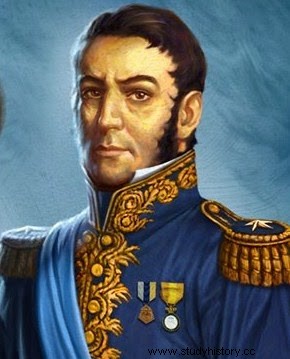 His father, Don Juan de San Martín y Gómez, had been born in Villa de Cervatos de la Cueza, in Old Castile, and was a captain in the Spanish army. In 1767, Doña Gregoria Matorras arrived in the country from Paredes de Nava, a town near Cervatos, where she met Juan. They were married in the cathedral of Buenos Aires. Don Juan could not be present and was represented by a friend, the captain of dragoons Juan Francisco de Somalo. The couple had five children:María Elena, Manuel Tadeo, Juan Fermín Rafael, Justo Rufino and the youngest of the family, José Francisco de San Martín.
His father, Don Juan de San Martín y Gómez, had been born in Villa de Cervatos de la Cueza, in Old Castile, and was a captain in the Spanish army. In 1767, Doña Gregoria Matorras arrived in the country from Paredes de Nava, a town near Cervatos, where she met Juan. They were married in the cathedral of Buenos Aires. Don Juan could not be present and was represented by a friend, the captain of dragoons Juan Francisco de Somalo. The couple had five children:María Elena, Manuel Tadeo, Juan Fermín Rafael, Justo Rufino and the youngest of the family, José Francisco de San Martín.3) What was Yapeyú like?
Yapeyú was founded by the Jesuits in 1627. Over the years it became the most important livestock center in the Río de la Plata, where the best shoes in the area were made and exported to Chile and Peru. Yerba mate was produced, boats were manufactured and an important music school was operating. After the expulsion of the Jesuits in 1767, economic activity declined notably, but Yapeyú continued to be an important city within the Spanish strategy for these lands.
4) Why did the San Martín family move to Spain?
In December 1783, Juan de San Martín requested and obtained permission to return to Spain. The family settles first in Madrid and then in Malaga, on Calle de Pozos Dulces. There José studied his primary studies, probably at the Temporalities school near his home, and on July 15, 1789, the day after the French Revolution broke out in Paris, José Francisco de San Martín was accepted as a cadet in the Regiment. Infantry of Murcia.
5) How were the first battles of San Martín?
Shortly after joining the regiment he participated in numerous combats in Spain and North Africa. Between 1791 and 1795 during the war between Spain and France, the young San Martín stood out in many battles such as those in Oran, the Pyrenees and Roussillon. He was promoted to lieutenant colonel and decorated with the gold medal for his heroic performance in the Battle of Bailén on July 19, 1808.
6) Why did he decide to return to the country?
San Martin had not forgotten his Creole origins and wanted to join the struggle for American independence. A year after the May Revolution, he requested the withdrawal of the Spanish army and embarked for London on September 14, 1811. San Martín spent four months in London. There he came into contact with revolutionary groups such as the Great American Brotherhood, a lodge founded by Francisco de Miranda, a Venezuelan patriot who intended to liberate America with financial help from the British. He was also related to politicians linked to the British government, such as James Duff and Sir Charles Stuart, who made him aware of the Maitland plan. In January 1812, San Martín embarked on the English frigate George Canning heading to Buenos Aires.
7) What was the Maitland Plan?
Thomas Maitland was a Scottish general who in 1800 wrote a Plan to capture Buenos Aires and Chile and then emancipate Peru and Quito . There he proposed to gain control of Buenos Aires, take positions in Mendoza, coordinate actions with an army in Chile, cross the Andes, defeat the Spanish and control Chile, continue by sea to Peru and liberate it. Everything seems to indicate that San Martín learned about the plan during his stay in London in 1811 and, years later, he would take it into account when developing his liberating strategy.
8) How was the political situation in Buenos Aires when San Martín arrived?
He governed the First Triumvirate made up of Feliciano Chiclana, Manuel de Sarratea and Juan José Paso. But the real power was in the hands of the secretary of government, Bernardino Rivadavia, who had been developing a very centralist policy without attending to the demands of the interior, increasingly harmed by the economic policy of Buenos Aires, which promoted free trade and maintained a exclusive port and customs revenues. In addition, the Triumvirate, for fear of alienating Great Britain (allied with Spain), stopped the independence process and had even sanctioned Belgrano for flying the flag.
9) How is he received? What mission is he entrusted to him?
He is received in Buenos Aires by the Triumvirate that respects his military rank of lieutenant colonel and commissions him to create a regiment to guard the coasts of Paraná against the danger of attacks by the Spanish coming from Montevideo. The new regiment will be called "Grenadiers on Horseback" and will be installed in the Retiro.
10) Which sectors does San Martín contact upon arrival?
Shortly after arriving, San Martín came into contact with the groups opposed to the Triumvirate, led by the Patriotic Society, founded by Bernardo de Monteagudo, and created, together with his travel companion, Carlos de Alvear, the Lautaro Lodge , a secret society whose main goals were Independence and the Republican Constitution.
11) What was the first political intervention of San Martín in Buenos Aires?
San Martín and his companions decided to act and on October 8, 1812 they marched with their troops, including the grenadiers, towards the Plaza de la Victoria (current Plaza de Mayo) and demanded the resignation of the triumvirs, because, As San Martín said:"...the troops are not always there to support tyrannical governments." A second Triumvirate related to the Lodge and the Patriotic Society was appointed, made up of Juan José Paso, Nicolás Rodríguez Peña and Antonio Álvarez Jonte.
12) Did San Martín speak with a Spanish accent?
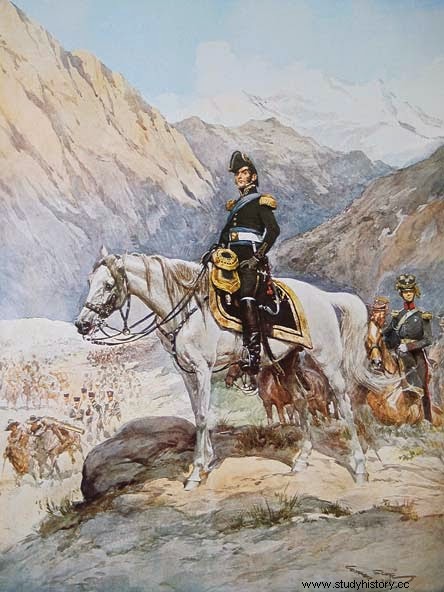 Don José had spent most of his life in Spain, particularly in the South, and therefore had a clear Andalusian accent. This is how those who knew him tell it, who also remember that he played the guitar very well and sang "cantes" typical of those areas of Spain.
Don José had spent most of his life in Spain, particularly in the South, and therefore had a clear Andalusian accent. This is how those who knew him tell it, who also remember that he played the guitar very well and sang "cantes" typical of those areas of Spain. 13) When and with whom did he marry?
Don José also made time for fun and little by little he was taken into account in the select guest lists of the Buenos Aires social gatherings. The most famous and pleasant, according to what they say, was that of Don Antonio Escalada and his wife Tomasa, in which his daughters, Remedios and Nieves, did not lose sight of any new visitor. Don José passed by there and it seems that it was love at first sight. "That woman has looked at me for life," he would say in a letter to his friend Mariano Necochea. They were married on September 12, 1812 in the Iglesia Nuestra Señora de la Merced, after a firm but brief opposition from the Escalada family. He was 34 years old and she was 15.
14) What was the first and only battle fought by San Martín in Argentine territory?
At the beginning of 1813 the grenadiers of San Martín were ready to undertake their first mission:to defend the coasts of the Paraná attacked by the Spaniards who sought by this route to relieve the blockade of the port of Montevideo, besieged by Rondeau. The Spaniards stole cattle and attacked the towns on the coast. San Martín followed the movement of the squadron by land and settled in the convent of San Carlos, post of San Lorenzo. There he waited for them until February 3, 1813, when some 300 Spaniards landed. San Martín ordered an encircling attack and the Spanish were pushed towards the river.
15) When and where did you plan to cross the Andes?
In 1814 he was entrusted with the command of the Army of the North, replacing General Belgrano. San Martín accepted the position but told the authorities that it would be useless to insist on the Upper Peru route and that he would retire to Córdoba to recover from the pain caused by his stomach ulcer and finish outlining the bases of his new military strategy consisting of cross the mountain range, liberate Chile and from there march by ship to take the royalist bastion of Lima. Partially recovered from his ills, but with the plan completed and approved, he managed to be appointed governor of Cuyo.
16) What measures did San Martín take as governor of Cuyo?
In Mendoza he began preparations for his ambitious plan without neglecting government tasks. He promoted education, agriculture, and industry. San Martín gave a great boost to the wine industry in Mendoza and San Juan by importing new strains and bringing European experts to the country to improve the quality of Cuyo wines and spirits. He created an egalitarian tax system taking care that those who had the most paid more.
17) When and where was his daughter born?
Mercedes Tomasa de San Martín was born in Mendoza on August 24, 1816. For this reason, in Mendoza her father's day is celebrated on that date. Mercedes stopped seeing her father when she was 4 months old, when she undertook to cross the Andes and she moved with her mother to Buenos Aires to her grandparents' house. Merceditas will only see her father again seven years later.
18) What participation did San Martín have in the Congress of Tucumán?
San Martín was not present at the sessions of the Congress, but he followed its development very closely through the deputy for Cuyo Tomás Godoy Cruz and supported Belgrano's proposal to crown an Inca king as sovereign of these provinces. Concerned about the delay in the Declaration of Independence, he wrote to Godoy Cruz asking him to convey his concern and that "it is a very ridiculous thing" that we have a flag, anthem and a rosette but that we are not independent.
19) How was the Army of the Andes financed?
It has been said many times that it was thanks to the jewels donated by the ladies of Mendoza's high society. This was not so. The total of what was obtained for the jewels that the rich ladies of Mendoza no longer used was 216 pesos, which at that time was barely enough to buy about 50 mules. The army was able to arm itself thanks to the sacrifice of the Cuyo people who donated clothes, pots, mules, weapons, food and even their salaries in order to form the liberating army.
20) How long did it take San Martín and his men to cross the Andes?
The Army of the Andes left Mendoza on January 12, 1817 and arrived in Chile on February 5. Throughout those 25 days, 5,400 men crossed the highest mountains in America with a temperature that ranged between 30 degrees during the day and 10 below zero at night. During many sections San Martín had to be transferred on a stretcher due to the terrible pain caused by the ulcer.
21) How does the freedom of Chile materialize?
Shortly after crossing the Andes, on February 12, 1817, the patriot forces defeated the Spanish on the Chacabuco slope. The excellent military tactics applied by San Martín allowed his troops to suffer only 12 dead and 120 wounded, while the losses of soldiers in the service of Spain reached 500 dead and 600 prisoners. The triumph of Chacabuco ensured the independence of Chile, which would be consolidated a year later, on April 5, 1818, after the definitive triumph of Maipú.
22) What support does San Martín receive for the expedition to Peru?
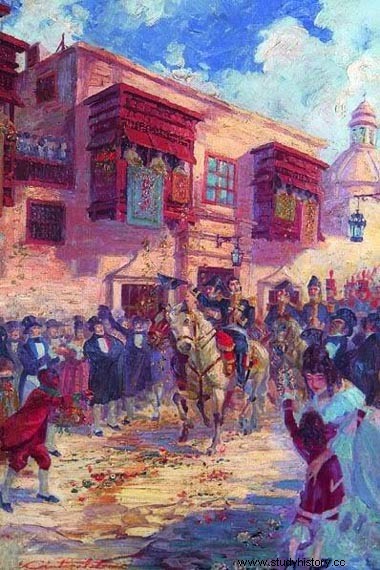 A few days after Maipú, San Martín crossed the mountain range again towards Buenos Aires to request help from the Directory government for the last stage of his liberation campaign:the maritime attack against the royalist bastion of Lima. He obtains the promise of an aid of 500,000 pesos for his Lima plan, of which only 300,000 will actually arrive. San Martín returned to Chile, where he obtained financial aid from the government of that country and put together a squadron, which will remain under the command of the Scottish sailor Lord Cochrane.
A few days after Maipú, San Martín crossed the mountain range again towards Buenos Aires to request help from the Directory government for the last stage of his liberation campaign:the maritime attack against the royalist bastion of Lima. He obtains the promise of an aid of 500,000 pesos for his Lima plan, of which only 300,000 will actually arrive. San Martín returned to Chile, where he obtained financial aid from the government of that country and put together a squadron, which will remain under the command of the Scottish sailor Lord Cochrane. 23) What was called the brilliant disobedience of San Martín?
When he was preparing to start the campaign he received the order from the Directory to march towards the Litoral with his army to fight the federals of Santa Fe and Entre Ríos. San Martín refused, declaring:"General San Martín will never draw his sword to fight his countrymen." He disobeyed and began the journey to Peru.
24) How was the Peru campaign?
On August 20, 1820, the liberating expedition departed from the Chilean port of Valparaíso. The squadron consisted of 24 ships and led some 4,800 soldiers. On September 12, the fleet anchored off the Peruvian port of Pisco. There the army supplied itself with food and increased its troops with the local inhabitants, among them many slaves, who voluntarily joined the liberating army. A division under the command of General Arenales went into the interior of Peru with the aim of revolting the population and won the important victory of Pasco on December 6, 1820. For his part, San Martín ordered the port of Lima to be blocked. Thus, Viceroy De la Serna was harassed on all sides and had to surrender on July 10, 1821. That day General San Martín entered the viceregal capital victorious.
25) How was the relationship between San Martín and Cochrane?
The enmity between the Scottish sailor Thomas Cochrane and San Martín began to take shape as soon as they sailed from Valparaíso to Lima. Cochrane was annoyed at having to obey San Martin's orders and generated numerous conflict situations during the trip. At the end of 1821, after the capture of Lima, arguing that several months of salary were owed to him, he took several ships from the fleet and fled to Chile, notably weakening the defense of the port of Callao.
26) How was San Martín's performance in Peru?
On July 28, 1821, San Martín declared the independence of Peru and was granted the title of Protector of Peru, with full civil and military authority. San Martín abolished slavery and personal services (mita and yanaconazgo), guaranteed freedom of printing and worship, created schools and the public library of Lima. He had to face serious financial difficulties, which created a growing discontent among the population. Despite the difficulties, San Martín was able to control the situation and achieve the surrender of the royalists in southern and central Peru.
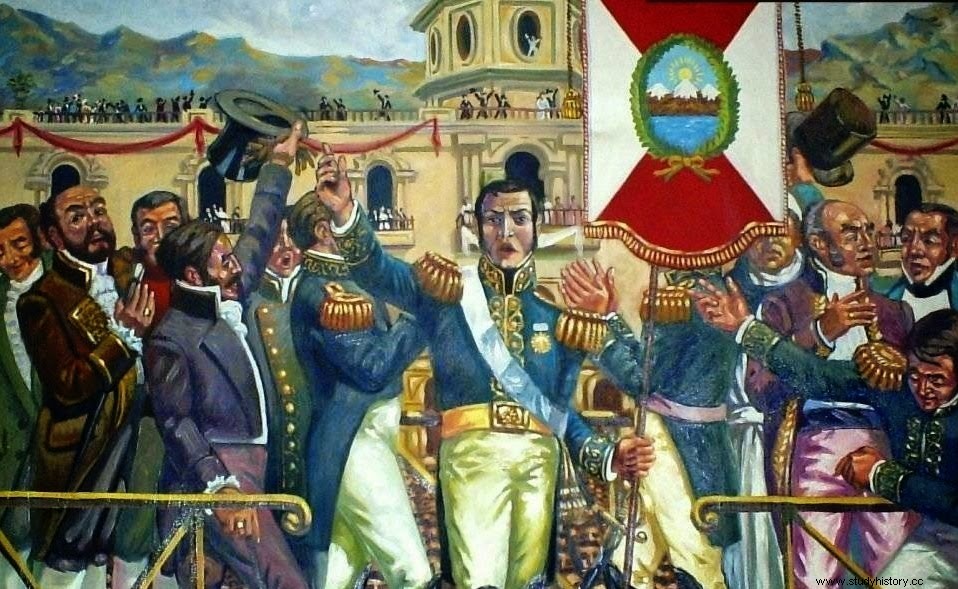 Proclamation of the independence of Peru 27) What happened in the Guayaquil interview? While San Martín carried out his campaign from the South, the Venezuelan patriot Simón Bolívar had been doing so from the North. Finally the two liberators decided to meet. The famous interview in Guayaquil (Ecuador) took place between July 26 and 27, 1822. There were political and military differences between them. While San Martín was in favor of each liberated town freely deciding its future, Bolívar was interested in personally controlling the political evolution of the new republics. The other controversial issue was who would lead the new liberating army that would result from the union of the troops commanded by both. San Martín proposed that Bolívar lead him, but Bolívar said that he could never have a general of the quality and capacity of San Martín as a subordinate. The Argentine general then made a drastic decision:to retire from all his positions, leave his troops to Bolívar and return to his country.
Proclamation of the independence of Peru 27) What happened in the Guayaquil interview? While San Martín carried out his campaign from the South, the Venezuelan patriot Simón Bolívar had been doing so from the North. Finally the two liberators decided to meet. The famous interview in Guayaquil (Ecuador) took place between July 26 and 27, 1822. There were political and military differences between them. While San Martín was in favor of each liberated town freely deciding its future, Bolívar was interested in personally controlling the political evolution of the new republics. The other controversial issue was who would lead the new liberating army that would result from the union of the troops commanded by both. San Martín proposed that Bolívar lead him, but Bolívar said that he could never have a general of the quality and capacity of San Martín as a subordinate. The Argentine general then made a drastic decision:to retire from all his positions, leave his troops to Bolívar and return to his country. 28) What did San Martín do after the interview?
After the interview in Guayaquil San Martín returned to Lima and resigned from his position as Protector of Peru and left for Chile where he remained until January 1823. He crossed the Andes for the last time and spent a few days in Mendoza from where he requested authorization to enter Buenos Aires and be able to see his wife who was seriously ill. Rivadavia, government minister of Governor Martín Rodríguez, denied him permission, arguing that the security conditions for San Martín to enter the city were not met. In reality, Rivadavia, who had always denied any type of help to San Martín, feared that the general would come into contact with the federals of the Litoral.
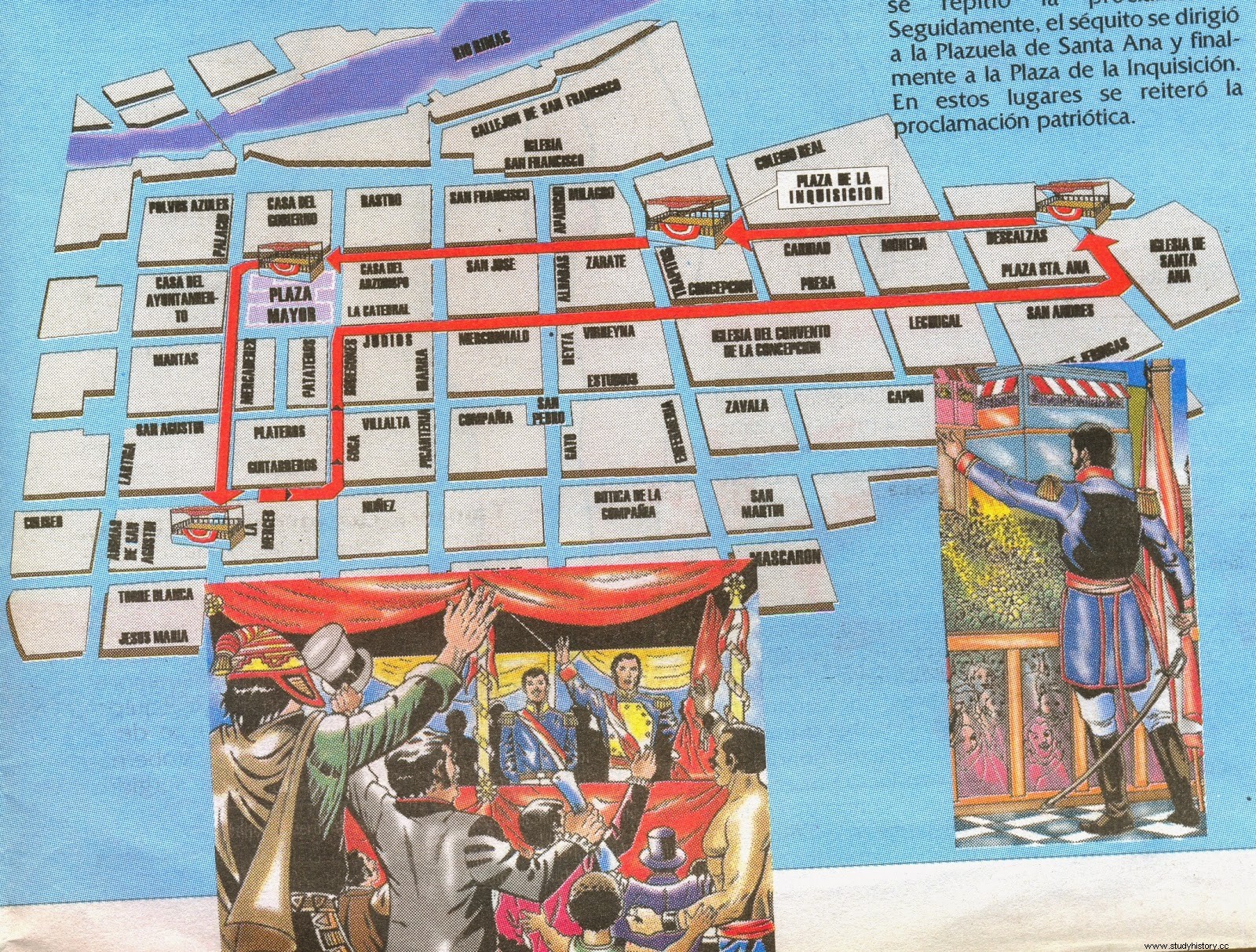 Places in Lima where independence was proclaimed 29) Why did he decide to leave for Europe? The governor of Santa Fe, Estanislao López, sent him a letter warning him that the government of Buenos Aires was waiting for the general's arrival to put him on trial for having disobeyed orders to repress the federals. San Martín thanked López for his warning but told him that he did not want any more bloodshed. Given the worsening of Remedios's health, San Martín decided to travel to Buenos Aires as well, but unfortunately he arrived late. His wife had already died without him being able to share at least his last moments. Defamed and threatened by the unitary government, San Martín decided to leave the country in the company of his little daughter, Mercedes, heading for Europe. After briefly passing through London, San Martín and his little daughter settled in Brussels. In 1824 they went to Paris so that Mercedes could complete her studies.
Places in Lima where independence was proclaimed 29) Why did he decide to leave for Europe? The governor of Santa Fe, Estanislao López, sent him a letter warning him that the government of Buenos Aires was waiting for the general's arrival to put him on trial for having disobeyed orders to repress the federals. San Martín thanked López for his warning but told him that he did not want any more bloodshed. Given the worsening of Remedios's health, San Martín decided to travel to Buenos Aires as well, but unfortunately he arrived late. His wife had already died without him being able to share at least his last moments. Defamed and threatened by the unitary government, San Martín decided to leave the country in the company of his little daughter, Mercedes, heading for Europe. After briefly passing through London, San Martín and his little daughter settled in Brussels. In 1824 they went to Paris so that Mercedes could complete her studies. 30) Why didn't he return to his country anymore?
San Martín was still interested and concerned about the situation in his country. In February 1829, he decided to return as a result of the war with Brazil. But when he arrived at the port of Buenos Aires, he learned of the overthrow of Governor Dorrego and his tragic execution at the hands of Lavalle's Unitarians. He then decided not to disembark. Many officers, both unitary and federal, sent letters to his ship and visited him with the intention that he take over power. San Martín refused because he believed that, whatever party he took, he would have to shed Argentine blood and he was not willing to do so. Sad and disappointed, he decided to return to Europe.
31) How was his relationship with Rosas?
In 1838, during the government of Rosas, the French blocked the port of Buenos Aires. José de San Martín immediately wrote to Don Juan Manuel offering him his military services. Rosas thanked him for the gesture and replied that the diplomatic efforts he could carry out with the governments of France and England could be as useful as his military services. Upon learning of the brave combat of the Vuelta de Obligado, on November 20, 1845, when the Creoles courageously faced the Anglo-French squadron, San Martín wrote to Rosas again and expressed his respect and congratulations. Perhaps because of this fact, the general ordered in his will that the saber that accompanied him in all his campaigns be given to don Juan Manuel de Rosas, because of the satisfaction he had "as an Argentine, because of the firmness with which that general upheld the honor of the republic against the unjust pretensions of foreigners who tried to humiliate it".
32) How were his last years? Saint Martin was going through a difficult economic situation in Europe. He could not expect anything from the Argentine government and neither Peru nor Chile regularly paid him the salaries that corresponded to him as a retired general. He lived off the meager income from renting a house in Buenos Aires and the help of some friends like the banker Alejandro Aguado who helped him buy his house in Grand Bourg. San Martin at that time was very ill. He suffered from asthma, rheumatism and ulcers and was almost blind. His state of health worsened until he died on August 17, 1850. INTERVIEW WITH SAN MARTÍN
